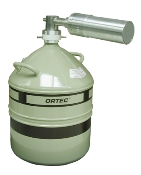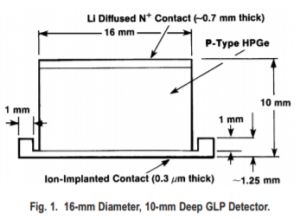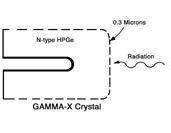Ametek Ortec – General Gamma Spectroscopy
 |
GEM High-Purity Germanium (HPGe)
Coaxial Detectors (in PopTop Capsule)
GEM Series HPGe detectors are manufactured with ORTEC’s own HPGe and represent the state of the art in “conventional”, i.e., outer contact Li diffusion and inner contact ion-implanted HPGe coaxial detectors. Because of the superior quality of ORTEC’s HPGe material, GEM detectors feature the best available energy resolution, peak-to-Compton ratios, and peak symmetry ratios at 1.33 MeV. Note that energy resolution and symmetry ratios are warranted to two decimal places.
- Large stocklist at all times
- Efficiencies to 150%, higher on request
- New “Application-Tuned” PROFILE Series available
- PopTop flexibility
- Excellent energy resolution and peak symmetry
- Automatic high-voltage shutdown protects preamplifier input FET
- Indicator warns of excessive counting rate
- PLUS preamplifier option for ultra-high-rate applications
|
|
|
 |
PROFILE Series
GEM HPGe Coaxial Detectors
PROFILE GEM detectors are a first in germanium detectors; a range of detectors from which you can choose the best solution for your application from specified crystal dimensions. They are available in 2 series of endcap sizes. Nominal relative efficiency specifications are provided in order to help relate relative efficiency to terms of crystal dimensions. The resolution is measured according to the IEEE standard.
Avalilable in F series which employ “over-square” (diameter > length) coaxial structures, FX series (with an ULTRA-thin Entrance Window), S-Series which have a semi-planar crystal geometry and employ a proprietary ultra-thin, stable entrance window to improve low energy efficiency, SP-Series which use a low-noise back contact in addition to the proprietary ultra-thin, stable entrance window, M series optimized for use with Marinelli Beakers or C-Series which provide all the attributes of the M-Series detectors combined with an ultra-thin, stable entrance window
|
|
|
|
|
GAMMA-X HPGe Coaxial Detectors
(in PopTop Capsule or Streamline Cryostats)
The GAMMA-X detector is a coaxial germanium (Ge) detector with an ultra-thin entrance window. While most coaxial detectors have entrance windows from 500- to 1000-µm thick, the entrance window of the GAMMA-X detector is a 0.3-µm-thick, ion-implanted contact. Ion implantation results in a totally stable contact which will not deteriorate with repeated cycling.
For Compton-suppressed gamma spectroscopy, for measurements involving spectroscopy over the widest energy range, and in any situation where neutron damage is likely.
- Efficiencies to over 100%
- PopTop flexibility
- Spectroscopy from 3 keV to 10 MeV
- ULTRA thin, ultra stable boron ion implanted outer contact
- High resistance to neutron damage
- Excellent timing characteristics
- Be window supplied with protective cover; Al or carbon fiber window option available at no additional charge
- High-rate indicator
- PLUS preamplifier option for ultra-high-rate applications
- Automatic high-voltage shutdown protects preamplifier input FET
|
|
|
|

|
GWL (Well) P-type Reverse Coaxial Radiation Detectors
ORTEC GWL Series High-Purity Germanium (HPGe) Well Detectors are a good solution for low level counting of small samples. The unique ion-implanted detector GWL (Well) P-type Reverse Coaxial Radiation Detectors well has an ultra-thin dead layer (only 0.3 μm thick), and therefore provides the most extensive useful energy range (10 keV to 10 MeV). Unlike other Well detectors that have a hole all the way through the germanium crystal, ORTEC’s Well Detectors have a “blind hole” with at least 5 mm of active germanium at the bottom of the hole.
This near 4 π geometry provides the maximum absolute counting efficiency available. The large well (1.55-cm diameter and 4.0-cm-long) accommodates an extensive range of sample sizes. Like all of ORTEC’s HPGe photon detectors, the HPGe Well detector may be stored or cycled repeatedly to room temperature without performance degradation.
GWL Series feature:
- Near 4 π geometry; high absolute counting efficiency for small samples.
- Spectroscopy from 10 keV to 10 MeV.
- Active Volumes to 400 cc.
- Unique ion-implanted blind well.
- Extra-large well (1.55 x 4.0 cm) standard.
|
|
|
|

|
GLP Series Planar HPGe Low Energy Radiation Detectors
- Excellent energy resolution in the 3 to 300 keV range
- Active area from 30 to 1000 mm2
- PopTop flexibility
- Unequaled timing performance
- Detectors larger than 36-mm diameter available
- Available with special feedback resistor for high-rate applications
- POF preamplifier option for superior energy resolution and high count rate at low energies
The ORTEC GLP Series Planar Low-Energy Photon Spectrometer (LEPS) is a small-area, high-purity germanium photon spectrometer for use in applications over the energy range from 3 to ~300 keV.
Available in diameters from 6 to 36 mm, the LEPS offers exceptional energy resolution for low and intermediate energies. At low energies in nuclear structure physics GLP detectors are irreplaceable because of their excellent timing performance.
|
|
|
|
|
SMART-1 Detector
ORTEC’s unique SMART-1 detector interface module is a new technology for the preamplifier and electronics interface. SMART-1 detectors contain a microprocessor that monitors the state of health of a detector at all times. Crystal temperature, preamplifier power (±12 and ±24), high voltage level and overload status are all monitored periodically while data is being acquired. If any single parameter fails, a latched bit is set. At the end of the measurement, SMART-1 enabled electronics (digiDART for instance) poll the state-of-health bit and if it is latched, the operator is warned that a parameter had exceeded limits during some part of the measurement. This feature ensures that the data acquired is of the highest possible integrity.
|
|
|
 |
905 Series NaI(Tl) Scintillation Detectors
The high Z of iodine in NaI(Tl) crystals result in high efficiency for gamma-ray detection. Resolution for a 3-inch diameter by 3-inch length crystal is typically about 7% for 137Cs and slightly worse for larger sizes. The light decay time constant for a NaI(Tl) crystal is about 0.23 ms. Typical charge-sensitive preamplifiers translate this into an output voltage pulse with a rise-time of about 0.5 ms. Fast coincidence measurements cannot achieve the very short resolving times that are possible for plastic scintillators, especially at low gamma-ray energies.
The Model 905 Series offers various sizes of Nal(TI) detectors.
905-1 (1” x 1”): 0.17 @0.5 MeV and 0.09 @2.0 MeV
905-3 (2” x 2”): 0.75 @0.5 MeV and 0.45 @2.0 MeV
905-4 (3” x 3”): 2.00 @0.5 MeV and 1.30 @2.0 MeV
|







